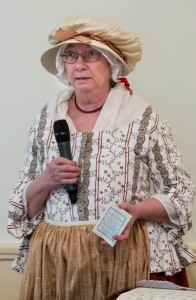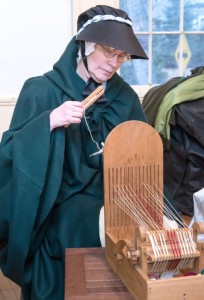By Ann Needle

Friday night, the Stow Historical Society attempted to answer the title question. The conclusion: Stow may never know much about how the town participated in the shot heard ’round the world—yet, anecdotes abound about the period surrounding the first Patriot’s Day.
The Historical Society’s Barbara Sipler launched last week’s dinner meeting by observing that 1775 Stow resident John Gates’ diary was chockfull of the minutiae of daily life, such as weather conditions. However, come the April 19 entry, Sipler observed there were all of about two sentences on the day, partially reading, “’This was a day never known…a civil war began in this Province.’
“Fascinating, just fascinating,” she continued. “Why did he leave it blank? Did he not want to be seen supporting the Tories? Did he not want to be seen supporting the Patriots? And there’s never another entry about the War.”
Enter Revolutionary Way reenactors from the Stow Minutemen, who regularly recreate Stow, circa 1775, through events such as campouts and battle reenactments. Stow Minutemen Captain Bob Stokes reviewed the events leading up to Gates’ blank page, and what may have happened in Stow that day.
As many residents know, the Stow Minutemen strive to re-create the citizen militia of 1775. Today’s Stow reenactors are perhaps best known for leaving Stow in the very early hours of April 19 to join up with militia from Concord, before arriving at that town’s North Bridge. (Today’s Stow Minutemen march a similar route on Patriots’ Day, staring at 4:30am.)
Stokes noted that Stow’s original ad hoc, volunteer army started out during the French and Indian War of the mid-1700s. “The Colonists came over, and there was no military support from Britain, and we had to protect against the Indians and later, the French.”
After the French and Indian War ended in 1763. Stokes explained that British mistrust likely began building that year. That is when England’s King George issued his Proclamation, which blocked settlement by Colonists west of the Alleghenies, supposedly because of the Indian threat in the area.
“Part of life here was the promise you could start your own family, start your own life,” Stokes emphasized. “And then the King’s taken that away from us.”
Stokes reviewed the many Acts of history lessons that ratcheted up Colonial anger against Britain, from the Sugar to the Stamp and Townshend acts — all aimed at pumping up English tax receipts — and leading up to the Boston Massacre in 1770, where five were killed and six wounded. The Boston Tea Party of 1773 helped trigger more Acts.

The “Drinking Party” Ends
Until martial law was imposed on Boston in 1774, Stokes noted that most local militia members saw their groups as “more of a drinking party.” Come 1774, however, the Stow Minutemen and other militias became more professional, getting paid and stepping up their drills, he said.
For many, Stokes said it was time to learn how to use rifle cartridges— “and the British weren’t eager to teach us. So our females went out and ‘hooked up’ with their soldiers,” coaxing that information from these men” (another point for American ingenuity).
As for what happened in Stow on Patriot’s Day, Stokes lamented, “One of the biggest regrets of my life is that blank page in John Gates’ diary.” Without firstperson reports, Stokes explained that one story has the Stow Minutemen in Concord by noon, while another has this militia not leaving until then, which Stokes said he tends to believe is correct.
“Why were we so late? It was not clear exactly what the British goal was when they marched out.” Stokes theorized, “But it’s all speculation.” However, he said it is known that, when word spread the British were heading west by land, Stow was one of three towns to take the bulk of battle supplies other towns sent out here to stash.
Stokes said it also is known at least two companies (Whitcomb and Hapgood) marched from Stow that first Patriot’s Day, and possibly a third. Daniel Conant was the day’s sole casualty from Stow, but even that piece of information ends in a mystery. Conant wasn’t on the Whitcomb company’s list, where he should have been. The theory is he lived closer to North Maynard — and, hence, Concord — at the time, so he marched ahead on his own, Stokes commented.
Statistics Stokes offered put the average age of the 1775 Stow marchers between 31 and 32. The youngest Stow Minuteman was just under 17, while the oldest (Jason Whitney) was almost 71. Of the 81 men in the Stow militia, more than half were born in the town. He added that this age was not unusual, given the average Colonial resident lived to age 70.
One question put to Stokes was an old one from town historians: Was Henry Gardner’s chest really found in the MA State House? (Gardner was elected provincial treasurer in 1775 by the Third Provincial Congress.) Stokes wryly remarked, “There are about 17 chests around that could have belonged to Henry Gardner.”
Asked how today’s Stow Minutemen know the path of the original Stow militia to Old North Bridge, Stokes explained that his predecessors at the Minutemen studied old maps and other documents, mapping out the likely path through Maynard, Acton, and then Concord.
“Again, it’s a lot of guess work,” Stokes remarked. “That’s why we exist as a unit, to honor their memory.”
Anyone wanting to walk with the Stow Minutemen on this Patriot’s Day, April 21, can check the route at www.stowminutemen.org. (Please note that, due to construction, there are a few route changes this year.)